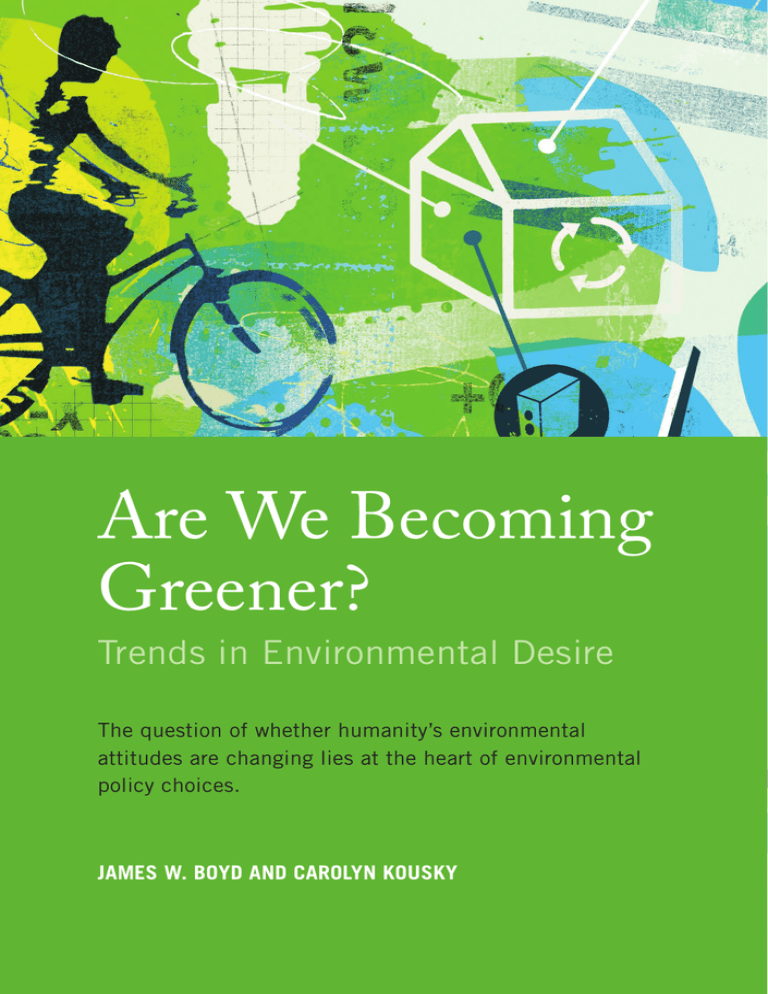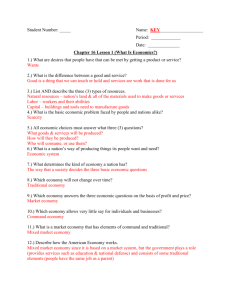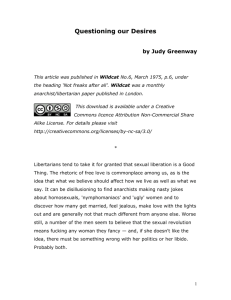
Are We Becoming
Greener?
Trends in Environmental Desire
The question of whether humanity’s environmental
attitudes are changing lies at the heart of environmental
policy choices.
JAMES W. BOYD AND CAROLYN KOUSKY
26
RESOURCES | NO. 191 | WINTER 2016
D
© Stuart Kinlough/Ikon Images/Corbis
o you care more about the environment now than when you
were a kid? Do you care more
than your parents did? You may think that
the answer to both is an obvious yes. After
all, people used to litter, live with dirtier air
and water, and not recycle. Our grandparents probably never uttered the word
“sustainability.” But does society as a whole,
including people in other countries, care
more than a generation ago?
The strength of our environmental
desires is of central importance to developing efficient and effective environmental
policies. Yet the typical assumption in
economics is that our desires don’t change
over time. We think about our behavior
and choices changing as environmental,
technological, and economic conditions
change. But economists operate as if our
deeper environmental desires—our fundamental attitudes, beliefs, and values—are
static. Might our hearts and minds be as
changeable as those other conditions?
The discussion matters because it goes
to the core of basic questions: Are we overor underprotecting the environment? Are
we protecting the right things and doing
so in the best ways?
How Do Desires, Behavior, and
Preferences Differ?
Our environmental behavior and choices
have certainly changed a lot over the last
few decades. We recycle, drive hybrid cars,
and buy organic food. It’s tempting to view
these behavior changes as evidence that
something has changed in our desires—
that is, our beliefs, psychology, values, or
JAMES W. BOYD is a senior fellow at RFF and
director of RFF’s Center for the Management of
Ecological Wealth.
CAROLYN KOUSKY is an RFF fellow.
ethics—that makes us more environmental.
But behaviors and preferences can change
for other reasons. The distinction between
preferences and desires is important
because it highlights that preferences and
behavior can change—without a change in
underlying desires.
Consider people who buy hybrid cars.
Many do so out of altruism, a desire to
express one’s green values, or to conform to
their community’s norms. But others may
prefer hybrids simply because they think
gas prices will rise.
Technological development is another
confounding factor. We may buy hybrid
cars, energy-efficient laundry machines, and
renewable power for environmental reasons,
but technological advancement is what
makes those purchases possible. Similarly,
people may increasingly buy those things
simply because their incomes have risen.
Changing desires can change behavior,
but changing preferences, choices, and
behavior do not necessarily imply a change
in desires.
What Makes Desires Change?
What does it mean when our beliefs,
psychology, values, and ethics do, in fact,
change? To tackle that question, we introduce three related concepts: taste formation, experience and learning, and norms.
Taste formation describes how and
why we like or dislike certain things. Half
a trillion dollars is spent on marketing
every year in the belief that tastes not only
change, but that they can be changed deliberately. But unlike fashion and fads, some
environmental tastes may be particularly
resistant to manipulation because they’re
hardwired into our psychology, much like
our tastes for certain foods. Several studies have shown that consistently and across
cultures, people tend to aesthetically prefer
WWW.RFF.ORG/RESOURCES
27
28
RESOURCES | NO. 191 | WINTER 2016
more empirical work would have to be done
to make strong causal predictions.
Norms (or “crowd knowledge”) relate
to collective knowledge and experience as
well as a collective understanding of what is
right or wrong and desirable or undesirable
in a community. They can be thought of
loosely as the social version of (individual)
tastes and, like tastes, can change over
time. Changes in crowd knowledge and
environmental norms can drive changes in
our environmental desires. For example, a
deeper empirical understanding of nature’s
role in our health, psychology, and economy
reinforces our more fundamental environmental beliefs and attitudes.
Can We Measure—and Predict—
Changing Environmental Desires?
It seems obvious that desires and tastes
change. Taste in art, food and drink,
personal aesthetics, and political attitudes
suggest that our deeper beliefs and attitudes
can and do shift. We’ve described a variety
of ways desires change, but careful empirical
© Stuart Kinlough/Ikon Images/Corbis
open landscapes dotted with visible water
and patches of forest to other types of
landscapes. Open landscapes allow us to see
predators and prey; water is fundamental to
survival; and forests signal shelter and food.
None of this means that our environmental tastes don’t change, just that these
changes may be harder to spot.
Experience and learning refers to the
acquisition of new concepts, facts, and
skills. Learning implies change, at least
in our knowledge and understanding, but
potentially also in our beliefs and values.
Does learning about the environment
strengthen or change our environmental
desires? Does experiencing nature change
our desire for it?
Indeed, a number of economic studies
and surveys show that direct experience
with a natural resource tends to have a
positive impact on the value given to the
resource. And there is evidence that childhood experiences can condition people’s
preferences for certain environmental
settings. However, our sense is that much
evidence is scant. That’s particularly true of
environmental desires and tastes. Why?
Economic Measurement
The focus of environmental economics
is on the measurement of behavior and
choices. People’s behavior and choices
provide evidence about their preferences
for one thing over another. (Do they prefer
clean air to cheap energy, or bald eagles to
land development?) Economists take this
approach because it is relatively easy to get
data on behavior and choices and because
the goal of most environmental economic
analyses is to reveal the trade-offs associated with those behaviors and choices as a
guide to public policy.
One explanation for the lack of empirical
study of “taste change” within economics is
the difficulty of isolating taste change from
other factors affecting preferences. Studies
must employ methods and data to control
for changes over time in supply, scarcity,
and substitutes. Illustrative exceptions that
prove the rule are studies of changing food
consumption patterns. For example, economists have empirically explored changes in
US beef consumption and tried to isolate
the effect of changes in the taste for beef
from other factors affecting consumption, such as prices, household income,
and demographic change. When these
latter factors are controlled for, the residual
change in consumption can be attributed to
a change in taste (in this case, perhaps arising from changed attitudes toward health).
Could environmental economists
conduct analogous studies to detect environmental taste changes? In principle, yes.
In practice, data limitations currently make
it nearly impossible. Taste change studies of
market commodities like beef can make use
of a variety of data on prices and consumption. These data are collected consistently
“A number of economic
studies and surveys show
that direct experience
with a natural resource
tends to have a positive
impact on the value
given to the resource.”
at regular intervals over time (allowing for
time-series analysis). Such data are relatively
abundant because the goods in question are
market goods, and markets generate a great
deal of routinely collected information on
prices and consumption. Environmental
goods and services, however, are usually
not market goods and thus lack price and
consumption data. To be sure, environmental economists spend much of their time
deriving “virtual prices” and gathering data
on environmental consumption related to
things such as outdoor recreation. But environmental goods lack the routine, consistent
collection of data associated with market
commodities. As a consequence, environmental economics has, to date, produced
few, if any, studies of how virtual environmental prices or consumption change over
time—let alone analyses designed to isolate
taste change from supply, scarcity, and
substitutes.
One way to move forward (which, to our
knowledge, has not been attempted) is to
create and repeatedly administer over time a
national or global environmental preference
survey designed to detect environmental
taste change. Any such study would require
a long-term financial and institutional
commitment. It would also require a design
that reflects best practice stated preference
methods, which are used to get around
WWW.RFF.ORG/RESOURCES
29
the “missing prices” problem associated
with nonmarket environmental goods.
They involve the construction of realistic, plausible decision scenarios that ask
respondents to make (simulated) choices.
By comparing people’s choices between
nonmarket environmental goods and money
or goods with a known market value, the
value or preference for environmental goods
can be inferred. (For example, would you
rather have a new park or a lower property
tax bill?) To be clear, such an endeavor
would involve more than simply conducting repeated experiments because, as noted
earlier, detection of taste change requires
careful attention to confounding factors,
such as changes in supply, scarcity, and the
availability of substitutes.
Another approach would be to examine
how environmental desires vary crosssectionally in response to different conditions. For example, research has been
undertaken in experimental economics
to examine cross-country differences in
variables such as trust and reciprocity. These
studies have participants play economic
games designed to examine certain types
of behavior and compare how outcomes
differ around the world. We could imagine
something similar being done to compare
environmental desires in different countries.
Although it would be challenging to isolate
the factors that are the underlying causes
for differences, useful patterns could emerge
showing correlations between variables such
as income, education, or various institutional
structures and environmental desires.
Opinion Polls
Forget about complicated economic methods; can’t we just look at opinion polls to tell
us about our changing environmental attitudes? Not really. Although opinion polling
has its uses (predicting near-term voting
patterns, for example), it does a poor job of
revealing our underlying beliefs, desires, and
attitudes and how they change over time.
To begin with, it’s rare for environmental
polls to be conducted consistently over long
periods of time, which makes it hard to see
changes. Gallup polls are one exception;
several extend back to the 1970s and 1980s
(almost no environmental polling existed
prior to that time).
Figure 1. Prioritizing Environmental Protection versus Economic Growth, 1984–2014
With which one of these statements about the environment and the economy do you most agree—protection
of the environment should be given priority, even at the risk of curbing economic growth (or) economic
growth should be given a priority, even if the environment suffers to some extent?
% Environment
90
% Economic growth
71
61
68
49
60
30
44
28
0
1984
24
19
1986
1988
1990
1992
1994
1996
1998
2000
2002
2004
2006
2008
53 54
50
38 36
41
2010
2012
2014
Copyright © 2014 Gallup, Inc. All rights reserved. The content is used with permission; however, Gallup retains all rights of republication.
30
RESOURCES | NO. 191 | WINTER 2016
Figure 2. Americans’ Support for Prioritizing the Environment over the Economy versus Annual US
GDP Growth, 2000–2013
Net support for prioritizing the environment^
% year-to-year change in US GDP (average for prior year)
39
4.8
4.1
18
24
1.1
2000
2001
2002
1.8
5
2003
2.5
5
2004
3.5
3.1
2.7
17
15
18
2005
2006
2007
1.9
7
2008
2.4
-0.3
-9
2009
-15
-3.1
-18
2010
2011
1.8
2.2
-8
-5
2012
2013
^Net = % who would make protecting the environment the priority minus % who would make economic growth the priority.
Copyright © 2013 Gallup, Inc. All rights reserved. The content is used with permission; however, Gallup retains all rights of republication.
Since 1984, Gallup has been asking
Americans about whether they place higher
priority on economic growth or environmental protection. The results and precise
wording of the question are depicted in
Figure 1.
Through the 1980s and 1990s a significant majority of respondents favored
environmental protection. The gap narrows
beginning around 2000 and, in fact, in 2009
and 2011–2013 a majority prefers economic
growth. Does this imply that Americans’
environmental preferences are weakening?
No, for at least two reasons.
First, legislation, regulation, and investment in environmental protection expanded
significantly over the 30-year period. In
the 1980s, the major environmental laws
in the United States were just beginning
to be implemented, following a surge of
legislation and regulatory change beginning in the 1970s. In other words, baseline
“environmental protection” increased over
the period. With status quo levels of environmental protection getting stronger, it’s
not surprising for people to give additional
environmental protections a lower priority
over time. Rather than evidence of weaker
environmental desires, the numbers may
just reflect the increased satisfaction of our
desires over those 30 years.
Second, the numbers may simply reflect
that people’s relative desire for economic
growth increases when economic growth
falls. Consider Figure 2, which relates
Figure 1 (now expressed as “support for
prioritizing the environment over the
economy”) to changes in US gross domestic
product (GDP). The correlation suggests
that what’s changing over the period is our
desire for economic growth, not our environmental desires.
Another issue with the Gallup polling
(which we pick on only because there are
so few other examples) is its reliance on
the term “environmental protection.” The
term is vague and thus subject to various
interpretations by respondents and readers
alike. Our guess is that many respondents
reasonably equate “environmental protection” with “environmental regulation by the
federal government.” If so, the survey may
conflate attitudes toward the environment
with attitudes toward government. Figure
3 shows why that matters to interpretation
of the poll. Over the past 40 years distrust
WWW.RFF.ORG/RESOURCES
31
Figure 3. Views of Biggest Threat to US in Future
In your opinion, which of the following will be the biggest threat to the country in the future—big
business, big labor, or big government?
% Big government
% Big business
% Big labor
80
72
70
65
60
47
50
50
38
40
30
20
10
35
24
22
29
19
17
8
21
10
5
0
1965
1969
1973
1977
1981
1985
1989
1993
1997
2001
2005
2009
2013
Copyright © 2013 Gallup, Inc. All rights reserved. The content is used with permission; however, Gallup retains all rights of republication.
in “big government” (itself a vague term)
has grown significantly. This is yet another
potential explanation for the decadal decline
in the environment versus growth priority
ranking.
In fact, viewing the polls together, it is
remarkable how strong the preference for
environmental protection (Figure 1) remains
given the countervailing trends: the improvements over time in baseline environmental
protection, dips in economic growth, and
increased distrust in government.
Are We Becoming More Environmental?
Given those headwinds, can we conclude
that our underlying environmental attitudes
have grown stronger over the last 30 years?
Yes. Maybe. We hope so. Pertinent data are
sparse and over a decadal scale limited to
US opinion polling that suffers from a host
of interpretive challenges. Although empirical measurement of our underlying envi-
32
RESOURCES | NO. 191 | WINTER 2016
ronmental attitudes and tastes is possible,
assessment of long-term, cross-cultural
changes in environmental desires would
require a fairly heroic commitment to new
data and empirical methods.
Our survey, as well as our own personal
intuition, leads us to conclude that our
desires change, and in some situations can
be changed deliberately. The difficulty for
prediction, however, is the variety of factors
that drive our psychology and attitudes. Do
our childhood experiences trump the norms
of our adult community? Are our attitudes more affected by learning and social
messaging or by institutions that govern the
way we interact with one another?
Consider the pronounced global trend
toward urbanization and its effect on our
environmental desires. One argument is that
urbanization is likely to weaken environmental desires, via our increasing detachment from natural experiences in childhood
© Stuart Kinlough/Ikon Images/Corbis
or psychological adaptation to nature’s
unobtainability. But urbanization is also
associated with educational opportunities
and social interactions that could strengthen
environmental desire.
Given such countervailing winds, prediction requires deliberate strategies to empirically measure trends in our environmental
desire. The difficulty of doing so largely
explains why the environmental social
sciences have so far not provided adequate
evidence one way or the other. But difficulty
isn’t a great excuse for ignoring something so
fundamentally pertinent to our environmental policy choices.
Changes in humanity’s environmental
desires matter. If we predict stronger environmental desires in the future, then policy
choices based on our current strength of
desire will tend to underprotect the environment. And conversely, if we expect a weakening, current policy will tend to overstate
the benefits of environmental improvement.
Our hope is to encourage greater attention (particularly among our colleagues in
economics) to the way humanity’s deeper
environmental desires, values, and attitudes
may be changing.
·
This article is excerpted from a related blog series on
Common Resources. Read the full series at
www.rff.org/blog/environmentaldesire.
WWW.RFF.ORG/RESOURCES
33






